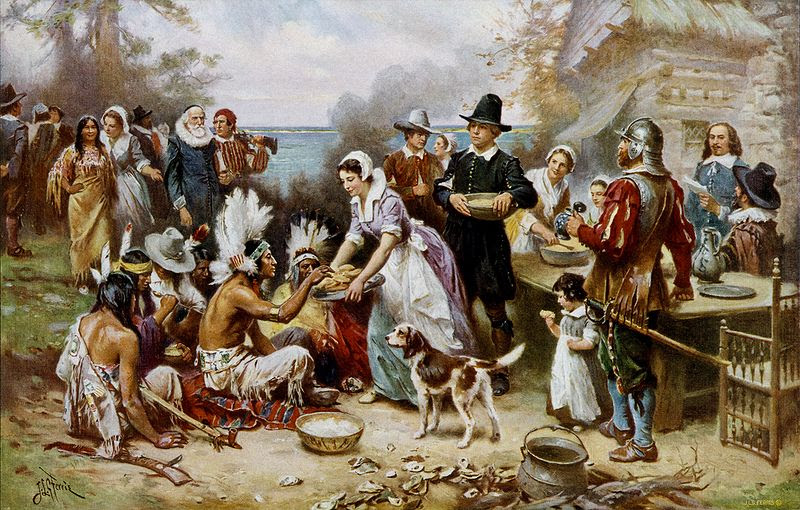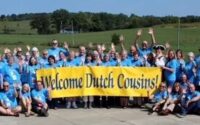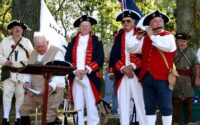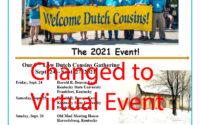Happy Thanksgiving to Dutch cousins 11/26/2020

The pilgrims actually went to Amsterdam first, where it all was going smoothly for a while. After spreading out to live in Leiden and building new lives, the Pilgrims realised they were changing too much. Worse: they were losing their religion.
In 1620, the pilgrim’s emigration from Leiden — where they had worked for about 12 to 20 years — truly began. They left Leiden via the canals, transferred onto a leaky ‘Speedwell’ (a ship built in 1577) in Delfshaven, then finally boarded the famous Mayflower in Southampton.
Every year in Leiden there is a Thanksgiving Day Service held at the Pieterskerk, a beautiful church. One of the pilgrim leaders, John Robinson, is actually buried here, which makes it all the more interesting to visit. Or slightly creepy. Or both.
(from Dutch Review)
—————————————–
SENT BY : Kurt Wullschleger (of Florida)
We have all heard of the Low Dutch colonies at Conewago, Harrodsburg and in Switzerland, Jefferson and Johnson Counties in Indiana, but how many have heard of Carlyle, Kansas?
THE FOUNDING OF CARLYLE, KANSAS
NOTE: This article first appeared in the Hopewell Herald in Franklin, IN, on 3 Sep 1915. It was reprinted in Jan, 1966, in the Treesearcher, the magazine of the Kansas Genealogical Soc.
An interesting ceremony was observed on Wednesday afternoon, August 25, 1915. In the presence of three men who might be called by those who count only in years, a little stone marker was set up by the gate leading from the Hopewell Manse. [A Manse is the residence of a Presbyterian parochial minister.] In the stone was placed a copper box containing letters and some writings which shall be history for the next generation.
Fifty-eight years ago to the day, there set forth from this gate for Kansas seven young men: William Cozine, Richard Ditmars, Stephen Combs, Peter [Marion] Carnine [son of Andrew & Nancy, bapt 3 May 1835], Archibald and Garrett Van Nuys, and Jackson Utterback, the first four of whom are living, and the first three present at this time.
The matter of western immigration had long been talked of. The Hopewell Academy had attracted many youths outside of the community as well as within it. In a live debating society the problems of the day were earnestly discussed. The political situation of Kansas was more than once the topic of conversation. It was felt by many that the time was ripe for sending out a settlement from the old community. So the older men were to go by train to Kansas City; this was the end of the line. There they were to be met by these seven young men, provided with two wagons and teams, who were to drive overland and take the whole party on from Kansas City. On August 25, 1857, the neighbors gathered at the home of Mrs. Cozine, which later became the Hopewell Manse, and there they said good-bye to the boys. It was a very serious parting. To the great unknown west there were going; there were many dangers possible. The party was accompanied by some of the neighbors as far as Waverly, where the first stop was made on White River. There, T. P. Killen made the boys a farewell speech, which they all remember. He urged upon them the necessity of close organization on their journey; they took his advice. All seven boys were members of the Hopewell Church, and real Christians. They did not travel on Sunday. Twenty-two days they were on the road, not including three Sundays. All this, R. V. Ditmars told in his remarks.
Mr. Cozine told the story they all vividly remember. As they drew near Kansas City, not much of a city then, however, four of the boys decided they would walk on, and reach town sooner than the wagons. A rain came up suddenly, and, to avoid getting wet, they dodged into the trees as we know it, but under some scattering trees; they hurried from tree to tree, seeking the best comfort. It was important that their one suit of clothes be kept dry. Their actions aroused suspicion. A little while before, a bank in the vicinity had been robbed, and seven thousand dollars in new money taken. As soon as the boys reached the city, two of the four were arrested, the other two escaping to tell the horrible tale to their approaching comrades. Fortunately, the elder members of the company had reached Kansas City the previous evening. To make such close connections as these, when one party went by team and the other by train, must have taken nice calculation. The senior members of the party sought to explain to the officials the movements of the boys, but the two boys were kept in jail all night, and the whole party was searched for new money. The mistake was humbly acknowledged the next morning, but there were some sore feelings towards the officials of the city.
Leaving Kansas City, the two wagons were now crowded. After travelling together a short time, the party divided, one wagon going south into the beautiful country along the Neosha, on to the Geneva prairie, where a pocket was formed by the Martin and Deer Creeks. Here, the colony settled, taking up claims on the land which had not yet been put into market. After the settlements, they all returned home except Richard Ditmars and Peter Carnine, who remained through the winter, building a cabin and looking after the claims. When spring came, a large colony of settlers arrived many of them from the Hopewell neighborhood; among them were David Covert [This was an error, it was Daniel], and his three sons; John Newton [son of Daniel & Rachel, bapt 16 Aug 1631]; Dr. George W. [bapt 1 Dec 1833], and Samuel H. [bapt 22 May 1836], all heads of families. T. P. Killen, and Dr. [John?] Scott, who was the practicing physician of the colony, were elected elders in the church which was almost immediately organized, the Carlisle [Carlyle] Presbyterian Church which had thirty-seven charter members. [Peter Madison Luyster and his family joined the new settlement in 1859.]
The second wagon turned west by south, going by Emporia toward the Indian Council House, which took the name of Burlingame. Here, [Stephen] Combs, [one of the] Utterback[s], and [Richard] Ditmars were left for the winter to look after the claims and build a cabin or two. When the winter was over, other colonists arrived; among them were: William T. and Margaret (Wheat) Voris, and Addison Cozine, brother of William; and here also a church was organized, with ten charter members, of whom three were from Hopewell.
And now, after these fifty-eight years, three of the men and some of their friends gathered at the starting place to renew old memories. The services were very simple; reading of scriptures and prayer by Mr. Ferguson; the remarks of Mr. Cozine and Mr. Ditmars, and the placing of the stone by Messrs. Paul Covert and John McCaslin. The leading spirit of the movement has been William Cozine, who returned to Hopewell for a visit after an absence of forty years. We appreciate all these efforts to keep the past in the knowledge of the present. Such work as this is going far toward making the centennial year of Indiana count.
Have a blessed Thanksgiving week.
We have two volunteers to carry on the Dutch Letters. I was hoping for someone who has attended at least ONE of the Dutch Cousins Gatherings in Kentucky. Any takers?


